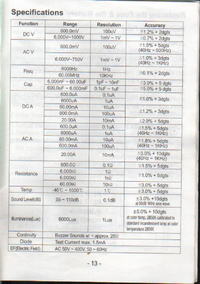Hello
lordpakernik wrote: Accuracy: +/- (0.8% +1)
Well, maybe I will also try to write something. In the old analog devices there was a parameter known as the accuracy class and everyone (well, almost everyone) knew what it was and how to approach it. The measurement uncertainty was due to the inaccuracy of the analog measurement unit, because it was the only one.
In digital meters, the measurement uncertainty is a component of the uncertainty of the measured value (here 0.8%) as well as a component of the uncertainty of the measuring range (here 1 digit). In the meters (and finally it is a voltmeter) there is a reference voltage, i.e. a reference voltage to which the value of the input (measured) voltage is compared. It should be remembered that both components of the measurement uncertainty come from terms
analog .
The measurement uncertainty of the digital element is 0 If the digital module starts to be wrong it should be replaced

PS Unfortunately, it is not so rosy that the more numbers, the greater the accuracy. There are many meters where, by definition, the last digits are something like a "random number generator" - such constructions have the right to exist on the market because they are calculated for buyers who only count the number of digits on the display instead of reading the manual (if any)

greetings
pm001



